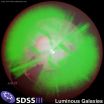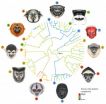(Press-News.org) SEATTLE – Among overweight and obese adults, a diet rich in slowly digested carbohydrates, such as whole grains, legumes and other high-fiber foods, significantly reduces markers of inflammation associated with chronic disease, according to a new study by Fred Hutchinson Cancer Research Center. Such a "low-glycemic-load" diet, which does not cause blood-glucose levels to spike, also increases a hormone that helps regulate the metabolism of fat and sugar. These findings are published online ahead of the February print issue of the Journal of Nutrition.
The controlled, randomized feeding study, which involved 80 healthy Seattle-area men and women – half of normal weight and half overweight or obese – found that among overweight and obese study participants, a low-glycemic-load diet reduced a biomarker of inflammation called C-reactive protein by about 22 percent.
"This finding is important and clinically useful since C-reactive protein is associated with an increased risk for many cancers as well as cardiovascular disease," said lead author Marian Neuhouser, Ph.D., R.D., a member of the Cancer Prevention Program in the Public Health Sciences Division at the Hutchinson Center. "Lowering inflammatory factors is important for reducing a broad range of health risks. Showing that a low-glycemic-load diet can improve health is important for the millions of Americans who are overweight or obese."
Neuhouser and colleagues also found that among overweight and obese study participants, a low-glycemic-load diet modestly increased – by about 5 percent – blood levels of a protein hormone called adiponectin. This hormone plays a key role in protecting against several cancers, including breast cancer, as well as metabolic disorders such as type-2 diabetes, nonalcoholic fatty liver disease and hardening of the arteries.
"Glycemic load" refers to how the intake of carbohydrates, adjusted for total grams of carbohydrate, affects blood-sugar levels. Lentils or pinto beans have a glycemic load that is approximately three times lower than instant mashed potatoes, for example, and therefore won't cause blood-sugar levels to rise as quickly.
Study participants completed two 28-day feeding periods in random order – one featuring high-glycemic-load carbohydrates, which typically are low-fiber, highly processed carbs such as white sugar, fruit in canned syrup and white flour; and the other featuring low-glycemic-load carbohydrates, which are typically higher in fiber, such as whole-grain breads and cereals. The diets were identical in carbohydrate content, calories and macronutrients. All food was provided by the Hutchinson Center's Human Nutrition Laboratory, and study participants maintained weight and physical activity throughout.
"Because the two diets differed only by glycemic load, we can infer that the changes we observed in important biomarkers were due to diet alone," Neuhouser said.
"The bottom line is that when it comes to reducing markers of chronic-disease risk, not all carbohydrates are created equal. Quality matters," she said. "There are easy dietary changes people can make. Whenever possible, choose carbohydrates that are less likely to cause rapid spikes in blood glucose." These types of low-glycemic-load carbs include whole grains; legumes such as kidney beans, soy beans, pinto beans and lentils; milk; and fruits such as apples, oranges, grapefruit and pears. Neuhouser also recommends avoiding high-glycemic-load carbohydrates that quickly raise blood glucose. These include highly processed foods that are full of white sugar and white flour, and sugar-sweetened beverages and breakfast cereals.
###
The study was funded by the National Cancer Institute's Transdisciplinary Research on Energetics and Cancer (TREC) Initiative, a nationwide research consortium that aims to better understand the link between obesity and cancer. The Hutchinson Center houses the initiative's coordinating center.
At Fred Hutchinson Cancer Research Center, our interdisciplinary teams of world-renowned scientists and humanitarians work together to prevent, diagnose and treat cancer, HIV/AIDS and other diseases. Our researchers, including three Nobel laureates, bring a relentless pursuit and passion for health, knowledge and hope to their work and to the world. For more information, please visit www.fhcrc.org.
A diet rich in slowly digested carbs reduces markers of inflammation in overweight and obese adults
Such a diet also increases a hormone that helps regulate metabolism of fat and sugar
2012-01-13
ELSE PRESS RELEASES FROM THIS DATE:
Astronomers find 3 smallest planets outside solar system
2012-01-13
PASADENA, Calif. -- A team of astronomers led by scientists at the California Institute of Technology (Caltech) has discovered the three smallest confirmed planets ever detected outside our solar system. The three planets, which all orbit a single star, are smaller than Earth and appear to be rocky with a solid surface. Until now, astronomers have found at most only four other rocky planets, also called terrestrial planets, around other stars.
The trio of new planets is too close to the central star to be in its habitable zone—the ring-shaped region around a star where ...
Hubble solves mystery on source of supernova in nearby galaxy
2012-01-13
Using NASA's Hubble Space Telescope, astronomers have solved a longstanding mystery on the type of star, or so-called progenitor, which caused a supernova seen in a nearby galaxy. The finding yields new observational data for pinpointing one of several scenarios that trigger such outbursts.
Based on previous observations from ground-based telescopes, astronomers knew the supernova class, called a Type Ia, created a remnant named SNR 0509-67.5, which lies 170,000 light-years away in the Large Magellanic Cloud galaxy.
Theoretically, this kind of supernova explosion is ...
New information on the waste-disposal units of living cells
2012-01-13
Important new information on one of the most critical protein machines in living cells has been reported by a team of researchers with the U.S. Department of Energy's Lawrence Berkeley National Laboratory (Berkeley Lab) and the University of California (UC) Berkeley. The researchers have provided the most detailed look ever at the "regulatory particle" used by the protein machines known as proteasomes to identify and degrade proteins that have been marked for destruction. The activities controlled by this regulatory particle are critical to the quality control of cellular ...
A clue to the GI problems that plague many kids with autism?
2012-01-13
January 11, 2012 -- New research conducted in the Center for Infection and Immunity (CII) at Columbia University's Mailman School of Public Health, reports that children with autism and gastrointestinal disturbances have high levels of a bacterium called Sutterella in their intestines.
Study findings are published online in the journal mBio.
The investigators found that over half of the children diagnosed with autism and gastrointestinal disturbances had Sutterella in intestinal biopsy tissue, while Sutterella was absent in biopsies from typically developing children ...
Treatment with light benefits Alzheimer's patients, Wayne State University finds
2012-01-13
Detroit - Exposure to light appears to have therapeutic effects on Alzheimer's disease patients, a Wayne State University researcher has found.
In a study published recently in the Western Journal of Nursing Research, LuAnn Nowak Etcher, Ph.D., assistant professor of nursing, reported that patients treated with blue-green light were perceived by their caregivers as having improved global functioning.
Caregivers said patients receiving the treatment seemed more awake and alert, were more verbally competent and showed improved recognition, recollection and motor coordination. ...
Rice's 'quantum critical' theory gets experimental boost
2012-01-13
New evidence this week supports a theory developed five years ago at Rice University to explain the electrical properties of several classes of materials -- including unconventional superconductors -- that have long vexed physicists.
The findings in this week's issue of Nature Materials uphold a theory first offered in 2006 by physicist Qimiao Si, Rice's Harry C. and Olga K. Wiess Professor of Physics and Astronomy. They represent an important step toward the ultimate goal of creating a unified theoretical description of the quantum behavior of high-temperature superconductors ...
ISG15: A novel therapeutic target to slow breast cancer cell motility
2012-01-13
Interferon-stimulated gene 15 (ISG15), a ubiquitin like protein, is highly elevated in a variety of cancers including breast cancer. How the elevated ISG15 pathway contributes to tumorigenic phenotypes remains unclear and is the subject of a study published in the January 2012 issue of Experimental Biology and Medicine. Dr. Shyamal Desai and her co-investigators from the Louisiana State University School of Medicine in New Orleans, the University of Pennsylvania School of Medicine in Philadelphia, and the Robert Wood Johnson School of Medicine in New Jersey report that ...
Calculating what's in the universe from the biggest color 3-D map
2012-01-13
Since 2000, the three Sloan Digital Sky Surveys (SDSS I, II, III) have surveyed well over a quarter of the night sky and produced the biggest color map of the universe in three dimensions ever. Now scientists at the U.S. Department of Energy's Lawrence Berkeley National Laboratory (Berkeley Lab) and their SDSS colleagues, working with DOE's National Energy Research Scientific Computing Center (NERSC) based at Berkeley Lab, have used this visual information for the most accurate calculation yet of how matter clumps together – from a time when the universe was only half its ...
Stenting for stroke prevention becoming safer in high-risk patients
2012-01-13
MADISON –Placing a stent in a key artery in the neck is safer than ever in patients ineligible for the standard surgical treatment of carotid artery disease, according to a new study published online today in the Journal of Vascular Surgery.
A team of researchers led by Dr. Jon Matsumura, head of the vascular surgery division at University of Wisconsin School of Medicine and Public Health, found the clinical trial PROTECT (Carotid Artery Stenting with Distal Embolic Protection with Improved System) had the lowest rate of complications ever in patients considered high ...
Evolution is written all over your face
2012-01-13
Why are the faces of primates so dramatically different from one another?
UCLA biologists working as "evolutionary detectives" studied the faces of 129 adult male primates from Central and South America, and they offer some answers in research published today, Jan. 11, in the early online edition of the journal Proceedings of the Royal Society B. The faces they studied evolved over at least 24 million years, they report.
"If you look at New World primates, you're immediately struck by the rich diversity of faces," said Michael Alfaro, a UCLA associate professor ...
LAST 30 PRESS RELEASES:
A new way to map how cells choose their fate
Numbers in our sights affect how we perceive space
SIMJ announces global collaborative book project in commemoration of its 75th anniversary
Air pollution exposure and birth weight
Obstructive sleep apnea risk and mental health conditions among older adults
How talking slows eye movements behind the wheel
The Ceramic Society of Japan’s Oxoate Ceramics Research Association launches new international book project
Heart-brain connection: international study reveals the role of the vagus nerve in keeping the heart young
Researchers identify Rb1 as a predictive biomarker for a new therapeutic strategy in some breast cancers
Survey reveals ethical gaps slowing AI adoption in pediatric surgery
Stimulant ADHD medications work differently than thought
AI overestimates how smart people are, according to HSE economists
HSE researchers create genome-wide map of quadruplexes
Scientists boost cell "powerhouses" to burn more calories
Automatic label checking: The missing step in making reliable medical AI
Low daily alcohol intake linked to 50% heightened mouth cancer risk in India
American Meteorological Society announces Rick Spinrad as 2026 President-Elect
Biomass-based carbon capture spotlighted in newly released global climate webinar recording
Illuminating invisible nano pollutants: advanced bioimaging tracks the full journey of emerging nanoscale contaminants in living systems
How does age affect recovery from spinal cord injury?
Novel AI tool offers prognosis for patients with head and neck cancer
Fathers’ microplastic exposure tied to their children’s metabolic problems
Research validates laboratory model for studying high-grade serous ovarian cancer
SIR 2026 delivers transformative breakthroughs in minimally invasive medicine to improve patient care
Stem Cell Reports most downloaded papers of 2025 highlight the breadth and impact of stem cell research
Oxford-led study estimates NHS spends around 3% of its primary and secondary care budget on the health impacts of heat and cold in England
A researcher’s long quest leads to a smart composite breakthrough
Urban wild bees act as “microbial sensors” of city health.
New study finds where you live affects recovery after a hip fracture
Forecasting the impact of fully automated vehicle adoption on US road traffic injuries
[Press-News.org] A diet rich in slowly digested carbs reduces markers of inflammation in overweight and obese adultsSuch a diet also increases a hormone that helps regulate metabolism of fat and sugar




